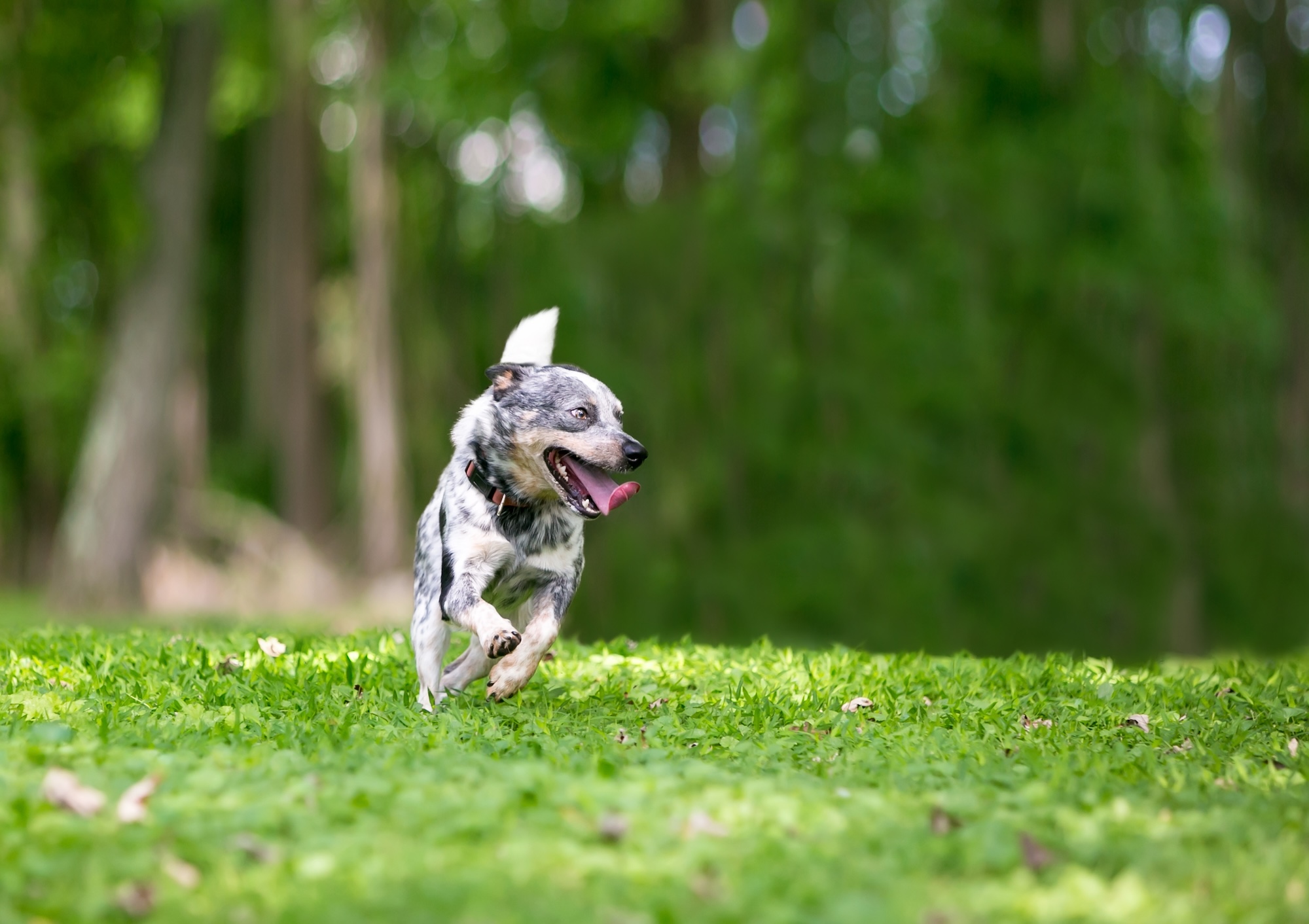There’s a lot riding on a dog’s ability to read the humans around them, and they make it their mission to do so. When you exhibit a new behavior around your dog, they probably watch you closely. Maybe they tilt their head as they study your every movement and sound in an attempt to figure out what’s going on.
If you’re a person who loves dogs, there’s much to gain from giving them that same courtesy.
“Dogs are infinitely patient with us, working hard to understand what we want and what we’re doing” says Dr. Alexandra Horowitz of Barnard College’s Dog Cognition Lab. “It’s worth it,” she says, for humans “to slow down and try to understand [them].”
Striving to get inside your dog’s head doesn’t mean giving up the simple joys of hanging out with your friend. “I think on some level when I interact with a dog it’s the same way I interacted with them when I was a little kid,” says Dr. Erin Hecht, an assistant professor who studies dogs’ brain anatomy at Harvard University’s Department of Evolutionary Biology. “But, on the other hand, there’s a part of my brain that’s watching them, trying to understand what they’re doing and why.”
Below, with help from these and other experts, we delve into what we know about how dogs think—and tackle the big questions about their inner lives.
How smart are dogs?
Dr. Stanley Coren, Professor Emeritus at the University of British Columbia, says that dogs’ mental capacities are similar to those of 2-to-3-year-old humans when it comes to learning new commands, and that keeping this in mind will help you teach a dog. “If you wouldn’t use the technique on a human 2-to-3-year-old,” he says, “then it’s certainly not going to work on your dog.”
But that doesn’t make an adult dog the intellectual equivalent of a human toddler. Dogs’ intelligence is suited to their own needs. Human children don’t exhibit instinctive abilities to write computer code, teach literature, or perform any number of work tasks weeks after being born, but herding dogs may show signs that they would be good at their job very early in their lives.
By human standards, humans will always be smarter than dogs—but there are areas like sense of smell in which dogs’ capabilities exceed ours. Consider dogs’ ability to, for example, sniff out cancers in their owners.
Behaviorist Dr. Ian Dunbar recalls studies testing the comparative searching abilities of dogs and children. Children seemed to excel when the task involved deduction—knowing that the object in question must be somewhere, they zeroed in on the remaining areas when earlier options were exhausted, speeding up as they went along.
But in another study that was more focused on following a scent, the dogs performed better than the humans. “When the dog gets the scent,” Dr. Dunbar says, “they move in all sorts of directions: left, right, left, right… ‘It’s going that way, it’s getting stronger that way.’ So there’s a cognitive process going on there—call it what you like, but the dog will find your car keys.”
These different sensory abilities also inform our efforts to determine whether dogs are self-aware. Traditionally, scientists have used the “mirror test” on animals, checking whether they seem to recognize their reflections in a mirror.
Dogs don’t “pass” this assessment, but Dr. Horowitz doesn’t think that means they’re not self-aware. She has conducted research seeming to indicate that dogs do recognize themselves… by scent, rather than sight.
So, how smart are they? We’re not about to see a pug win the Jeopardy Tournament of Champions. But it’s hard to beat dogs at what they do best.
What’s the smartest dog breed?
Dr. Coren’s ranking of dogs by working and obedience intelligence is frequently cited as a ranking of the “smartest” dogs, but he wouldn’t put it that way.
Dating back to the first edition of his book The Intelligence of Dogs, in 1994, Dr. Coren distinguished between three types of canine intelligence. The one that got the most attention was working and obedience intelligence, partly because it was easier than the others to quantify and rank. He compares it to “school learning.”
The obedience intelligence rankings measured how quickly dogs learned a command, and how reliably they followed it. To assemble them, Dr. Coren asked more than 200 obedience judges to document the performance of various breeds. Border collies famously ranked first by this measure, followed by poodles.
Coren discusses two other forms of intelligence in his book—instinctive and adaptive intelligence.
Instinctive intelligence is dogs’ ability to perform the tasks that they’ve been bred for. “I think it would take a wizard to be able to teach an Airedale to herd sheep,” Dr. Coren says of the terrier breed. “He’d be more apt to chase them and pull them down, or go crazy barking at them. It’s just not in his nature.”
He contrasts this with a breed whose ancestors were selected for their interest in and ability at herding: “I have seen an 8-week-old border collie showing the basic herding behavior virtually automatically.”
Humans who’ve lived with dogs hardwired for herding, digging, vocalization, and other behaviors know that you don’t have to teach them to do those things—and that the dogs may want to partake in such activities even if it’s not convenient for you.
Dr. Coren says that “adaptive intelligence” is “street smarts”—dogs’ ability to learn to do things for themselves.
A dog who’s not great at obedience intelligence can still be smart by these other measures. And be mindful that these are averages; your dog may not conform. Though breeding has produced dogs with certain predispositions, and humans should keep those in mind, dogs of the same breed can have large variations in intelligence and personality.
In studying MRIs of dogs’ brains, Dr. Hecht has found that “breeds that were historically specialized for bird flushing and retrieving had a significant association with a network of regions that are involved in moving the body, moving the eyes, and representing space—[and] you could see how that might be important if your job is to visually track something that’s moving across the environment and then bring it back.”
On the other hand, “breeds that were historically specialized just for human companionship had a significant link with the brain network that’s involved in social interaction and communication.” Every dog is an individual, but generations of breeding to perform certain jobs do seem to have produced patterns among dogs.
Keeping in mind these differences between humans and dogs—and among breeds and individual dogs—may make it easier for you to communicate with your own pup and meet their needs. If your dog seems bored or restless, they may be built for a different routine than the one you’re providing. “[Dogs’] brains are really wired to do particular jobs,” says Dr. Hecht. “And some of those jobs are sort of incompatible with being cooped up inside all day.”
How many words can dogs understand?
Dogs are good at learning words, and not only when they’re used in training. Even if you don’t intentionally teach a word to your dog, they can come to know what it means. Anyone who’s ever had to spell out “W-A-L-K” or “D-I-N-N-E-R” to maintain a tranquil home knows that dogs can recognize words and connect them with ideas. Some dogs have demonstrated an ability to absorb a huge number of them.
Chaser, a border collie who was known as “the world’s smartest dog,” learned to recognize the names of more than 1,000 objects by working for hours each day with her human, Wofford University professor John Pilley. She could also follow instructions related to the objects, understanding combinations of verbs and nouns—differentiating between taking an object and pawing at it, for example—as demonstrated in this footage.
Dogs can often seem to comprehend the meanings of full sentences, or at least grasp enough of the information therein to fulfill humans’ wishes. Dr. Dunbar relays a favorite story about one of his dogs, Phoenix: “I had just cooked lunch,” he remembers—but he couldn’t find his son, Jamie. “I called Phoenix,” he says. “‘Come here. Take this note. Go find Jamie.’ He went searching upstairs… down in the big room in the basement… outside… found him, and sat in front of him,” delivering the message that lunch was ready.
Can dogs read?
The idea of a dog reading might seem ridiculous at first glance; but, to a certain extent, they can. Dr. Coren has written about teaching dogs to read—work that he traces back to Dr. Bonnie Bergin in the 1970s. Dr. Bergin hoped that recognizing certain phrases and symbols could help dogs better assist the visually impaired by, for example, finding exits and restrooms. “I suppose that Bonnie and I are taking a certain degree of literary license by calling it ‘reading’ rather than ‘word recognition,’” says Dr. Coren. A dachshund is unlikely to curl up with a copy of this article, although we must emphasize that they are welcome to do so. In any event, dogs can be taught to recognize written words and symbols and act accordingly. For example, a dog could learn that a certain symbol means “leave it,” and, seeing a sign with said symbol, know to stay away from the area in question.
Is there such a breed as an English typesetter?
While dogs haven’t been specifically bred for typing, there is precedent for pups who hunt and peck. In the 1960s, Elisabeth Mann Borgese taught an English Setter, Arlecchino, how to type using a special typewriter outfitted with large keys. While Arli did not produce a bestseller—and his original “poetry” didn’t contain any apparent meaning—he was able to transcribe sounds. His human even let him type her Christmas cards. In one case, Mann Borgese said, Arli was able to connect the spelling of a word to its sound and meaning: In this video, she said that he would type “C-A-R” when he wanted to come along for a drive. He would most often make transcription mistakes when he was bored or under stress.
Can dogs really “talk?”
There’s been a recent trend of videos on social media starring dogs who “talk” using sound boards. Among the most prominent is Bunny, a sheepadoodle who has captivated users in posts that purport to show her using buttons to do far more than ask to be let outside. In this television segment, Bunny appears to let her human know that she has a foxtail caught in her paw by saying “ouch paw” and then extending it for examination. In another clip, asked the subject of a dream, she replies with “stranger animal.”
Dr. Coren has seen some footage of these “talking” dogs, and is not yet convinced that they’re “expressing linguistic knowledge.” Scientists are working to investigate what exactly Bunny and similar dogs are up to. At the University of California-San Diego’s Comparative Cognition Lab, Dr. Federico Rossano has been studying dogs like Bunny in a project called “TheyCanTalk.” The lab is working with FluentPet—a company that sells buttons for the aforementioned soundboards—to, in their words, “determine whether, and if so to what degree, non-humans are able to express themselves in language-like ways.”
Does Horowitz think dogs with sound boards are forming and understanding sentences with syntax? “I don’t,” she says, “nor would I expect them to. But they are communicating with us madly all day long, if we only spend time observing their behavior.” No matter what we learn from Dr. Rossano’s studies or other efforts to find the limits of dogs’ word usage, you can communicate effectively with your dog by watching their body language and relaying your feelings and wants to them in terms they can understand.
What emotions do dogs feel?
Most humans who have lived with dogs will tell you that, even in the absence of peer-reviewed studies proving it, they believe that dogs love people. And when you read stories like the one Dr. Coren references in this blog post, in which a dog overcomes a lifelong fear of the water to save his favorite human, it takes considerable mental gymnastics to come up with a more persuasive explanation than “he loves her.”
Dr. Dunbar, in pointing out how much praise can help in dog training, describes chemical and emotional processes taking place in human and canine alike.
“When you say ‘good boy, you’re a good dog,’” he says, “his tail wags, his butt waggles, and he gets a blast of dopamine and oxytocin. When you see your dog’s butt waggle, you get a blast of oxytocin and dopamine.” The bonding feels good for both of you—and it’s hard to label that phenomenon anything other than “love.”
The question of whether dogs feel guilt has received ample attention. There’s a widely circulating claim that dogs who seem to feel guilty are only reacting to humans’ cues. Dr. Marc Bekoff, professor emeritus of Ecology and Evolutionary Biology at the University of Colorado, Boulder, has written that a study by Dr. Horowitz cited by many (but not Dr. Horowitz herself) as “proving” that dogs do not feel guilt does no such thing.
While Dr. Horowitz says that dogs do not understand humans’ expectations of them or “the ‘rules’ of the house,” she’s also said that her study did not disprove the notion of dogs feeling guilty. Rather, it revealed more about humans’ ability (or lack of ability) to read dogs’ emotions. Bekoff writes that, given what we know about other mammals, “there’s no reason dogs shouldn’t feel guilt.”
Dr. Hecht acknowledges that, on one hand, “you can’t even know what emotions feel like for another human.” Nevertheless, her research suggests that dogs’ emotions may have a lot in common with ours. “We were looking at how differences in temperament [and] emotional profile across dogs are related to differences in brain anatomy,” she says, “and we found links between different types of emotional responses and [the] brain regions that control those emotional responses in humans.”
In other words: there seems to be physical evidence supporting humans’ gut reaction that dogs experience emotions like our own. Dogs can feel happy, sad, excited, or scared, and we should treat them accordingly.
What do dogs remember?
There’s uncertainty and debate over dogs’ memories, but we know that they remember quite a bit. The conception that dogs live exclusively in the moment is not really accurate.
In addition to learning and retaining the tricks, tasks, and words we’ve noted above, some scientists believe that dogs have what they call an “episodic-like” memory illustrated by an ability to repeat actions demonstrated by their humans up to an hour earlier. The team of scientists whose study is the basis of the linked article says that there’s no evidence of dogs being self-aware—see above—so they don’t go so far as to call pups’ memories “episodic.”
Studies seem to show that non-human mammals can dream about events that they remember—mice, for example, recalling mazes they’ve traversed.
Anecdotes about overjoyed dogs greeting humans that they haven’t seen for years would seem to confirm that dogs can remember specific people for a very long time. And, when we looked into how we could tell whether our dogs like us, Dr. Bekoff said that dogs “remember the things that we’ve done for them, both good and bad.”
Can a dog know that you’re kidding?
It’s not a good idea to prank your dog. A recent social-media trend in which humans would “bark” at their dogs seemed to mainly have the effect of confusing or alarming the pups in question. In some cases, it could be dangerous to the people involved. But that doesn’t mean that dogs take everything equally seriously. There’s reason to believe that they can understand actions as having different meanings depending on context.
“There is evidence that [dogs] understand when people do things accidentally versus on purpose,” says Dr. Hecht, “and I think there’s also evidence that they understand actions that appear to be mean or aggressive, but aren’t, in the context of play—a lot of dog play is fake aggression, and they have ways of letting each other know that it’s not real aggression.”
Dr. Bekoff, in a Psychology Today post, writes that dogs know when they and others are playing even though those behaviors can resemble some found in fighting and mating. “The random nature of play is one marker that dogs are indeed playing with one another,” he explains. “They know it and so do we.”
Play bows are one way that dogs can indicate the intentions of their behavior. You can relax if the dogs involved look happy, and they’re all in on the game. If your “prank” leads to stressed-out body language, that’s one of many hints that your friend doesn’t know your intentions.
“I wrestle with my dogs,” Dr. Hecht says, “and I think they understand that I’m not actually trying to hurt them.”
How can humans keep dogs’ minds sharp?
Too many dogs spend too much of their lives bored and lonely. If you regularly invest time in playing with your dog, training them, and exposing them to novel and interesting situations, you can help them harness more of their potential.
Dr. Coren notes research indicating that there are things humans can do to bolster dogs’ chances of staying sharper as they age—and they’re not too different from what people can do for themselves. “Keeping the dogs mentally active—providing them with new stimuli and new challenges—really does help,” he says. On the nutrition front, research indicates that diets with more of certain antioxidants can improve dogs’ cognitive function.
Just as humans can suffer from dementia, dogs can experience cognitive decline; this is especially common as they age.
Dogs who seem disoriented, develop new phobias, suddenly change their interactions with other dogs and people, or begin to vocalize more for what seems like no reason may be suffering from Cognitive Dysfunction Syndrome (CDS). Estimates vary, but by all accounts CDS symptoms are very common in senior dogs—and more likely the older a dog gets. While there is no cure for this condition, following the advice above has been shown to help dogs’ minds in the long run.
What does it all mean?
We’re far away from knowing exactly what it’s like in a dog’s mind—but doing your best to understand your dog’s perspective can make it easier to train them and forge a stronger bond, leading to a happier life for both of you.














